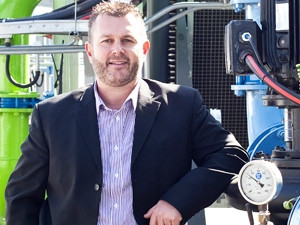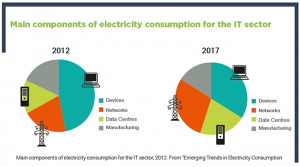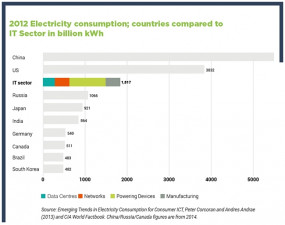
Although there are instances in which it makes sense to take a datacentre green, this needs to be balanced against how much it will cost, as renewable energy isn't exactly cheap.
Globally, datacentres are on the rise, and South Africa is no exception. However, given the country's dubious power situation - and the long-term benefits - going green may just pay off.
In May, Microsoft announced it will, for the first time, deliver its cloud suite from datacentres located in Africa. Its offerings, including Microsoft Azure, Office 365, and Dynamics 365, will be available from datacentres located in Johannesburg and Cape Town, with initial availability anticipated in 2018.
Ravi Bhat, Cloud and Enterprise Business Group lead at Microsoft South Africa, says, as the world increasingly races to a future based on cloud computing, a host of new and important public issues are emerging, which includes the energy and sustainability practices of the datacentres that power the cloud.
The business case
Ian Jansen van Rensburg, senior manager of Technical Pre-Sales at VMware, argues that "there are no circumstances under which it doesn't make sense to go green. Regardless of whether or not we have a functioning electrical grid, it is incumbent upon business to look to the future and better manage its use of finite planetary resources."
Bhat notes a datacentre can use far more power per square metre when compared to a standard office space. As a result, even minor efficiency improvements in datacentres can account for substantial savings.
In addition, Bhat notes, given the cost of electricity and concerns over outages, businesses also need to trim potential power constraints. They can, he says, look at virtualisation as an option.
In addition, says Bhat, small and medium enterprises don't have to invest in expensive technologies to optimise energy consumption and reduce costs. By migrating services to the cloud, companies can boost productivity while reducing the load on datacentre resources, carbon emissions, IT infrastructure and administration costs, travel as well as audio conferencing costs, he says.
In South Africa, Louise Taute, Comstor director at Westcon-Comstor Southern Africa, notes that the move to green is underpinned by energy costs as opposed to simply needing to be green. In addition, she says, in many African countries, where power is inconsistent and sometimes not available, the green datacentre is an even more urgent requirement.
Going green, says Taute, implies a new way of thinking and a new approach to technology. "Companies need to think beyond today and factor in future benefits."
Traditional vendors are having to innovate, says Taute, and companies such as VMware and Cisco are speaking to the concept of reducing emissions through virtualisation.
Taute says the cost of going green is coming down, and there are long-term savings to be had by going green. "Smaller, born-in-the-cloud businesses can save money immediately by deploying this approach, in networking hardware, rack spaces, blades and the like. The notion that it is too expensive is fast becoming an archaic one driven by proprietary vendors unable to make the change."
There are no circumstances under which it doesn't make sense to go green.
Ian Jansen van Rensburg, VMware
Teraco's head of Data Systems, Brendan Deysel, notes energy efficiencies within datacentre designs have become a prerequisite to any build or lifecycle replacement programme. He says operational savings in businesses are continuously in the spotlight and, with the rising electricity costs in South Africa, most businesses are looking at more efficient/greener options. However, Deysel notes, renewable energy poses a challenge where space is restricted, as the roof space will be dedicated to cooling equipment.
Pieter de Bod, technical director, WSP, Building Services, Africa, says one of the pushes towards going green is that it's marketable. "Like smart developers, datacentre owners have begun to realise that 'building green' and building for sustainability not only better enables the development to leverage on lowering power and water resources that are available, but it makes good business sense."
Current trends
Taute says virtualisation across the datacentre stack and hyperconvergence are really the main trends currently feeding this market. "Both technologies offer the customer the opportunity to use less 'tin' while making use of the same (if not more) processing power. It's a big motivator."
Paul Ruinaard, regional sales manager at Nutanix, notes that in the last ten years, virtualisation has been the single biggest trend in the greening of datacentres. "While it remains current, by exposing the inefficiencies of traditional datacentre infrastructure, it has become the driving force behind the move to hyperconvergence, a sleeker, more efficient and greener solution and the most current and upcoming trend in green datacentres."
Ruinaard adds that the `United States Datacenter Energy Usage Report', published in June 2016 and prepared by the Lawrence Berkeley National Laboratory, with support from the Department of Energy Federal Energy Management Program, references the emergence of virtualisation, along with the recession, as the major contributing factors to a decrease in the annual shipment increase of servers in the US to just five percent in the period 2005-2010. He adds this compares to the 15% annual server shipment increase of the previous five years. "Remember, fewer servers equals less power consumption and less environmental impact."
Companies need to think beyond today and factor in future benefits.
Louise Taute, Westcon-Comstor Southern Africa
Ruinaard says that when we talk about energy use in the datacentre context, it all comes down to scale. "The more hyperconverged the infrastructure, the less equipment, the smaller the footprint, and the lower the energy requirements."
Upcoming trends include elements such as energy-efficient lighting systems, ultrasonic humidifiers and direct/indirect free cooling systems, which Deysel says have become standard talking points during the design phase of datacentre builds. "Many datacentres are providing warmer environmental conditions to the server inlet, thus providing substantial energy efficiencies. This trend is very difficult to accommodate in the co-location industry due to the use of legacy IT equipment, which can't perform effectively in the warmer conditions."

Constraints
George Etheredge, Digital Transformation research analyst at Frost & Sullivan, says a key point that is often overlooked in the discourse around 'green' datacentres is that, in the end, a green datacentre is just a datacentre designed to minimise the environmental impact of its operations. "This means that, to be adopted, 'green' datacentres must offer tangible advantages over 'brown' datacentres."
Etheredge says a company considering moving towards greener datacentres should do so if such a move would offer an advantage relative to a standard datacentre. "If a green facility is cheaper than a traditional facility, the firm has a powerful incentive to 'go green'. There are also cases where a company may be able to attract customers based on the environmental impact of its operations. The most prominent example is Apple, a company renowned for targeting socially and environmentally conscious consumers."
In addition, says Etheredge, companies should look to adopt green datacentres if doing so makes business sense, and avoid being lured in by the hype surrounding the topic. "Should traditional power sources become steadily more expensive, and alternative power sources become steadily cheaper, the incentive to adopt green datacentres will become all the more powerful."
Taute says what's holding back this move, in some cases, is the initial set-up costs, maturity in some technologies, as well as the existing investments companies have in their existing technologies.
Deysel notes: "Once capital equipment is installed, a business case approval becomes increasingly difficult when capital items have not depreciated to an acceptable level. Only once lifecycle replacement programmes are initiated would an opportunity be provided to look at efficient greener solutions."
De Bod notes that a potential snag in uptake is that, on paper, the upfront capital investment required may seem intense. "However, as with any company re-investment or new development, it's important to evaluate the full lifecycle costs of any intervention." He adds that when one looks past the initial outlay and the time cost, the net present value of the project may still be positive.
In addition, says De Bod, there are also green funds and tax incentives that can contribute to making the business case more appetising.
Jansen van Rensburg says data growth is the greatest challenge to going green. "This growth is phenomenal worldwide and increasing rapidly year-on-year." He says the solution to this is to find ways to store data in a green way. "We can, of course, do this by consuming renewable energy, but that's not enough, because the more common renewables like wind and solar, while merit-worthy, are unreliable and expensive. We must therefore also dramatically reduce the gross amount of energy utilised to store these growing volumes of data. We can achieve this via virtualisation."
Despite the challenges, Taute says, green is an important factor for any company because of carbon taxes and green legislation. "But you can't just switch the lights off on one environment today and scale into a new one tomorrow. In many instances, we don't have the `green network' like many European countries where green energy is a de facto standard to support local implementations."
Deysel says that when there is an opportunity to go green, either through new builds or lifecycle replacement programmes, it makes sense to build datacentres as green as possible, especially on the mechanical side, which is based on the ambient environmental conditions.
Yet, Deysel says, in terms of renewable energy, the return on investment is difficult to motivate in a business case, due to high costs. Green datacentre designs provide better opportunities for business case approvals, due to the return on investment.
Despite this, there are pluses, says De Bod, as going green allows companies to reduce carbon emissions and increases their resilience to `uncertain service delivery'.

This article was first published in the July 2017 edition of ITWeb Brainstorm magazine. To read more, go to the Brainstorm website.
Share